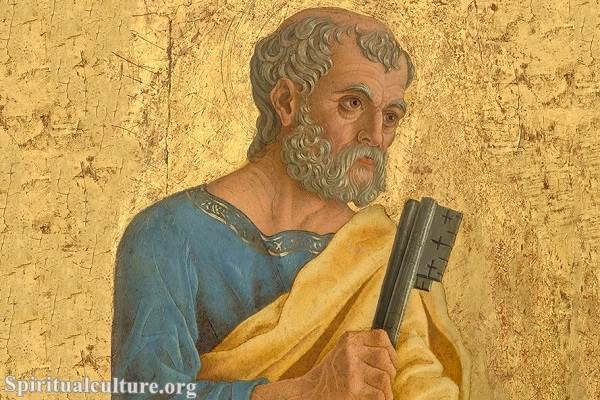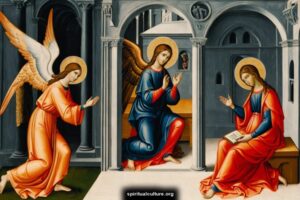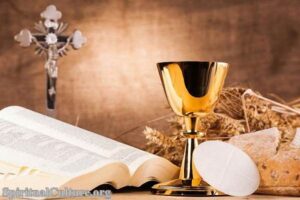I. Biography of Saint Peter
Simon Peter was born in Bethsaida, a village near the Sea of Galilee, and was a fisherman before he became a follower of Jesus.
Simon Peter first met Jesus through his brother, Andrew, who had become a disciple of Jesus. Jesus saw Peter fishing and called him to follow him, saying, “Come, follow me, and I will make you fishers of men.” Peter left his nets and his family to become a disciple of Jesus.
Saint Peter quickly became one of Jesus’ most loyal and devoted followers and played a prominent role in the Gospels. He was present at many important events in Jesus’ life, including the Transfiguration, the Last Supper, and the Garden of Gethsemane.
Saint Peter was also known for his impulsive and sometimes rash behavior. He famously denied Jesus three times after Jesus’ arrest, but he later repented and was forgiven by Jesus. After Jesus’ death and resurrection, Peter played a key role in establishing and spreading Christianity.
In the Book of Acts, Saint Peter is depicted as a leader of the early Christian Church. He delivered powerful sermons and performed miracles, including healing a crippled beggar and raising Tabitha from the dead. Peter also helped to spread Christianity among Jews and Gentiles.
According to tradition, Saint Peter traveled to Rome and became the first bishop of Rome. He is considered the first pope by the Roman Catholic Church and is venerated by many Christian denominations, including Catholics, Orthodox Christians, and Anglicans.
Saint Peter is often depicted in art with keys, as he is said to have been given the “keys to the kingdom of heaven” by Jesus. He is also the patron saint of fishermen, and his feast day is celebrated on June 29th.
Overall, Saint Peter was a key figure in establishing and spreading Christianity, and his leadership and devotion continue to inspire and guide Christians around the world today.

II. The facts about Saint Peter
Here are a few more interesting facts about Saint Peter:
- Saint Peter is often considered the patron saint of fishermen and is frequently depicted holding a fishing net or a fish.
- Peter was married, as evidenced by the Gospel of Matthew, which mentions that Jesus healed his mother-in-law. However, the Bible does not provide much detail about his wife, whose name is unknown.
- In addition to his role as a leader in the early Christian church, Peter is credited with writing two letters, known as First Peter and Second Peter, which are included in the New Testament.
- Peter is said to have been present at the first Pentecost, an event in which the Holy Spirit descended upon the apostles, empowering them to spread the message of Jesus to people of all nations.
- According to tradition, Peter was crucified in Rome on Vatican Hill, and a basilica was built over his burial site. This basilica, known as St. Peter’s Basilica, is now one of the world’s most famous and visited religious sites.
- Many miracles have been attributed to Saint Peter over the centuries, including healings, exorcisms, and the raising of the dead. These stories have contributed to his reputation as a powerful intercessor and a beloved saint in the Catholic Church and other Christian denominations.
- In Christian art, Saint Peter is often depicted with keys, representing the keys to the kingdom of heaven that Jesus gave him. This symbolism is based on a passage in the Gospel of Matthew in which Jesus says to Peter, “I will give you the keys of the kingdom of heaven, and whatever you bind on earth will be bound in heaven, and whatever you lose on earth will be loosed in heaven” (Matthew 16:19).
- In addition to his two letters, Peter is also mentioned frequently in the Gospels and the Acts of the Apostles, where he is portrayed as a bold and passionate leader of the early Christian movement.
- Peter’s name has been associated with many famous Christian sites and landmarks, including Saint Peter’s Square in Rome, St. Peter’s College at Oxford University, and the Peter and Paul Fortress in St. Petersburg, Russia.
- Peter’s legacy continues to inspire Christians around the world, who look to him as a model of faith, courage, and devotion to Jesus. His teachings and example remain an important part of Christian theology and tradition, and his story continues to be told and celebrated in churches, art, literature, and music.
III. Common questions about Saint Peter
1. Where was Saint Peter born?
According to Christian tradition, Saint Peter was born in Bethsaida, a village on the northern shore of the Sea of Galilee in Israel. This is also where Jesus is said to have performed several miracles, including feeding the 5,000. Saint Peter is considered one of the twelve apostles of Jesus and is recognized as the first pope of the Catholic Church.
2. When did Saint Peter die?
The exact date of Saint Peter’s death is not known with certainty, but it is believed to have occurred around the year 64 AD during the reign of the Roman Emperor Nero.
According to tradition, Saint Peter was crucified upside down in Rome, as he felt unworthy to be crucified in the same manner as Jesus. Saint Peter’s crucifixion site is believed to be where the current St. Peter’s Basilica stands in Vatican City.
Saint Peter’s feast day, which is a celebration of his life and legacy, is celebrated on June 29th in the Catholic Church.
3. How did Saint Peter die?
According to tradition, Saint Peter was crucified upside down in Rome, Italy, around the year 64 AD during the reign of the Roman Emperor Nero. The reason for his crucifixion was his preaching of the Christian faith, which was seen as a threat to the authority of the Roman Empire. It is said that Saint Peter requested to be crucified upside down as he felt unworthy to be crucified in the same manner as Jesus. Saint Peter’s crucifixion site is believed to be where the current St. Peter’s Basilica stands in Vatican City.
4. What is Saint Peter, the patron saint of?
Saint Peter is the patron saint of several groups and causes, including:
- Fishermen: Saint Peter was a fisherman before he became one of Jesus’ apostles.
- Rome: Saint Peter was the first pope of the Catholic Church and is considered the founder of the Church in Rome.
- Locksmiths: It is said that Saint Peter holds the keys to heaven, so he is the patron saint of locksmiths.
- Bridge builders: Saint Peter is also considered the patron saint of bridge builders because of his role as a bridge between the Jewish and Christian faiths.
- Universal Church: As the first pope of the Catholic Church, Saint Peter is considered the patron saint of the Universal Church.
- Papacy: Saint Peter is also considered the patron saint of the papacy, which is the institution of the pope in the Catholic Church.
- Courage: Saint Peter is known for his courage and steadfastness in the face of persecution, and as a result, he is considered a patron saint of courage.
- Footwear: Saint Peter is also considered the patron saint of footwear, particularly shoes, as it is said that he often went barefoot or wore simple sandals.
- Bakers: In some traditions, Saint Peter is considered the patron saint of bakers, as he is said to have blessed a baker who provided him with bread during his travels.
- Sailors: Some consider Saint Peter the patron saint of sailors, as he was often depicted as holding a boat or a ship, and his role as a fisherman made him closely associated with the sea.
- Net makers: As a fisherman, Saint Peter is also considered the patron saint of net makers.
- Popes: Saint Peter is the first pope of the Catholic Church and is considered the patron saint of all subsequent popes.
- Rome’s former enemies: Saint Peter is also sometimes considered the patron saint of those who were once enemies of Rome but have since been reconciled with the city and the Church.
- Rome’s civil defense: Saint Peter is considered the patron saint of Rome’s civil defense, as he is said to have appeared in a vision to the Emperor Constantine, instructing him to use the symbol of the Chi-Rho (a monogram of the first two letters of the Greek word for Christ) as a symbol of his army’s victory in battle.
- Harvesters: In some traditions, Saint Peter is considered the patron saint of harvesters, particularly those who work with wheat and other grains.
- Butchers: In some regions, Saint Peter is considered the patron saint of butchers, as he is said to have miraculously provided a piece of fish to a group of butchers who were seeking his help.
- Fishmongers: Saint Peter is also considered the patron saint of fishmongers due to his role as a fisherman and his association with fish.
- Confirmation: In the Catholic Church, Saint Peter is considered the patron saint of the sacrament of Confirmation, which is when a baptized person is sealed with the gift of the Holy Spirit.
- Unity: Saint Peter is considered a symbol of unity in the Catholic Church, and as a result, he is sometimes considered the patron saint of unity.
- Forgiveness: Saint Peter is also considered a patron saint of forgiveness, as he is said to have asked for forgiveness from Jesus after denying him three times before the crucifixion.
5. Why was Saint Peter crucified?
According to Christian tradition, Saint Peter, one of the twelve apostles of Jesus, was crucified upside down in Rome during the reign of Emperor Nero. The exact reasons for his crucifixion are not entirely clear, but there are several accounts that provide some insight.
One theory suggests that Peter was crucified for his role in spreading the Christian faith in Rome, which was then considered a threat to the Roman Empire’s social and political order. Another theory suggests that he was targeted because of his close association with Jesus and his leadership within the early Christian community.
Regardless of the reason, Saint Peter’s crucifixion is an important event in Christian history, and he is regarded as one of the most important figures in the early Christian Church. His crucifixion is celebrated annually in the Catholic Church on June 29th as the Feast of Saints Peter and Paul.
6. What is Saint Peter known for?
Saint Peter is known as one of the twelve apostles of Jesus Christ and is considered the first Pope in the Roman Catholic Church. He is also known for his leadership role among the apostles and his important contributions to the early Christian Church.
Peter is often depicted holding the keys to the kingdom of heaven, a reference to the biblical passage where Jesus says to him, “I will give you the keys of the kingdom of heaven, and whatever you bind on earth shall be bound in heaven, and whatever you loose on earth shall be loosed in heaven” (Matthew 16:19).
Peter is also known for his denial of Jesus three times, which is recounted in the Gospels. Despite this, Jesus forgave him, and he went on to become a prominent leader in the early Church, preaching the Gospel and performing miracles.
Peter’s death is believed to have occurred in Rome, where he was crucified upside down during the reign of Emperor Nero. Today, he is widely venerated as a saint in many Christian denominations, and his feast day is celebrated on June 29th.
7. What did Saint Peter do?
Saint Peter, also known as Simon Peter, was one of the twelve apostles of Jesus Christ and is considered to be one of the most important figures in Christianity. He was originally a fisherman from Bethsaida, a village near the Sea of Galilee, and Jesus called him his disciple.
According to the Bible, Peter was a prominent figure among the disciples and was often seen as their leader. He was present at many of the most important events in Jesus’ life, including the Transfiguration and the Last Supper. Peter is also famously known for denying Jesus three times during his trial but later repenting and being forgiven by Jesus.
After Jesus’ death and resurrection, Peter became a leader of the early Christian church, preaching and spreading the message of Jesus throughout the Roman Empire. He was instrumental in the formation of the early church and is believed to have written two books in the New Testament, First Peter and Second Peter.
According to tradition, Peter was eventually martyred for his faith, being crucified upside down in Rome during the reign of Emperor Nero. Many Christians consider him a saint, and his feast day is celebrated on June 29th.
8. Was Peter crucified upside down?
9. How old was Peter when he died?
10. Story of Peter in the bible summary




